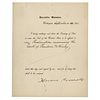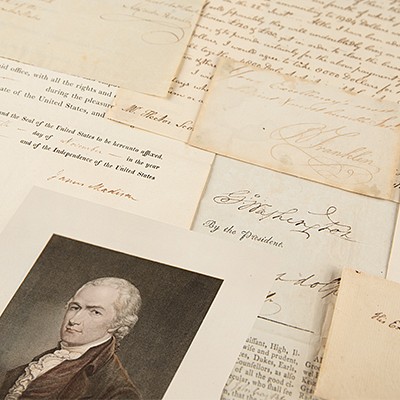President Theodore Roosevelt Delivers His First Proclamation, Announcing the Death of William McKinley
Two ways to bid:
- Leave a max absentee bid and the platform will bid on your behalf up to your maximum bid during the live auction.
- Bid live during the auction and your bids will be submitted real-time to the auctioneer.
Bid Increments
| Price | Bid Increment |
|---|---|
| $0 | $5 |
| $50 | $10 |
| $200 | $25 |
| $500 | $50 |
About Auction
Oct 11, 2023
RR Auction support@rrauction.com
- Lot Description
Partly-printed DS as president, one page, 8 x 10, Executive Mansion letterhead, September 14, 1901. President Roosevelt directs the Secretary of State to cause the Seal of the United States to be affixed to “my Proclamation announcing the death of President McKinley.” Signed boldly at the conclusion by Theodore Roosevelt. Includes an original black-bordered 8.25 x 13.25 print of Roosevelt’s presidential proclamation, which bears an affixed signature of the Secretary of State, John M. Hay. In fine condition.
Presidentially signed documents pertaining to the death of a past American president are appreciably rare and are seldom offered at auction. What makes this particular example of even greater scarcity is the unusual nature of McKinley’s death: on September 6, 1901, during the president’s planned visit to the Pan-American Exposition in Buffalo, New York, McKinley was shot twice in the abdomen at close range by anarchist Leon Czolgosz, succumbing to his wounds eight days later on September 14, 1901, the very day that Roosevelt signed this document. McKinley is one of four presidents to bear this uniquely tragic American hallmark, a distinction made all the more profound given that McKinley himself signed a death proclamation for 23rd President Benjamin Harrison only six months prior.
While on vacation in Isle La Motte, Vermont, Vice President Theodore Roosevelt was delivered with the news of McKinley’s shooting. He rushed to Buffalo to the president’s side and was soon overjoyed with reports that McKinley’s health was improving. Assured by physicians that the president would live, an optimistic Roosevelt returned to the forest, venturing into the Adirondacks for a family camping trip and a hike of Mount Major. On September 13th, a runner brought Roosevelt the news that McKinley was quickly fading. After a series of perilous wagon rides, Roosevelt reached North Creek Station early the next morning, where he was promptly handed a telegram confirming the president’s death. Roosevelt traveled on to Buffalo and the house of Ansley Wilcox, the location where he would that afternoon take the Oath of Office. Immediately following the swearing-in, Roosevelt held a brief cabinet meeting in the Wilcox library and then proceeded to the morning room to issue his first presidential proclamation.
Roosevelt’s proclamation reads, in part: “To the people of the United States: A terrible bereavement has befallen our people. The President of the United States has been struck down; a crime not only against the Chief Magistrate, but against every law-abiding and liberty-loving citizen. President McKinley crowned a life of largest love for his fellow men, of earnest endeavor for their welfare, by a death of Christian fortitude; and both the way in which he lived his life and the way in which, in the supreme hour of trial, he met his death will remain forever a precious heritage of our people. It is meet that we as a nation express our abiding love and reverence for his life, our deep sorrow for his untimely death.
Now, therefore, I, Theodore Roosevelt, President of the United States of America, do appoint Thursday next, September 19, the day in which the body of the dead President will be laid in its last earthly resting place, as a day of mourning and prayer throughout the United States. I earnestly recommend all the people to assemble on that day in their respective places of divine worship, there to bow down in submission to the will of Almighty God, and to pay out of full hearts the homage of love and reverence to the memory of the great and good President, whose death has so sorely smitten the nation." - Shipping Info
-
Bidder is liable for shipping and handling and providing accurate information as to shipping or delivery locations and arranging for such. RR Auction is unable to combine purchases from other auctions or affiliates into one package for shipping purposes. Lots won will be shipped in a commercially reasonable time after payment in good funds for the merchandise and the shipping fees are received or credit extended, except when third-party shipment occurs. Bidder agrees that service and handling charges related to shipping items which are not pre-paid may be charged to a credit card on file with RR Auction. Successful international Bidders shall provide written shipping instructions, including specified Customs declarations, to RR Auction for any lots to be delivered outside of the United States. NOTE: Declaration value shall be the item’(s) hammer price and RR Auction shall use the correct harmonized code for the lot. Domestic Bidders on lots designated for third-party shipment must designate the common carrier, accept risk of loss, and prepay shipping costs.
-
- Buyer's Premium



 EUR
EUR CAD
CAD AUD
AUD GBP
GBP MXN
MXN HKD
HKD CNY
CNY MYR
MYR SEK
SEK SGD
SGD CHF
CHF THB
THB












